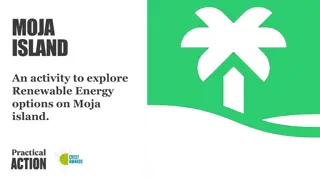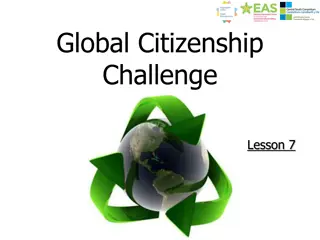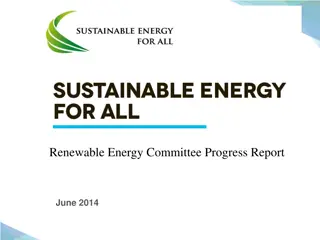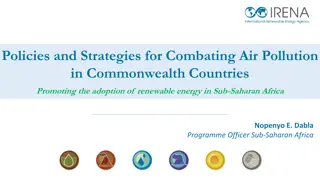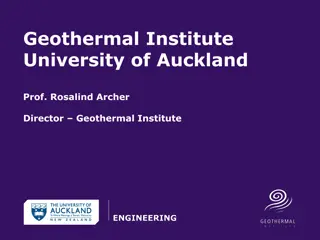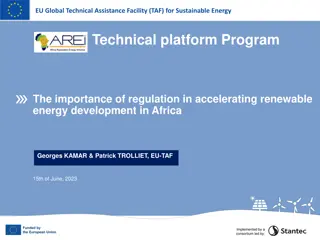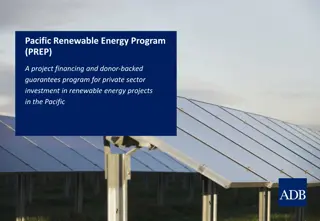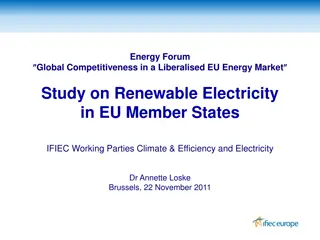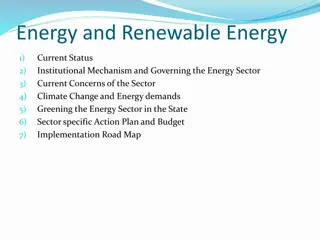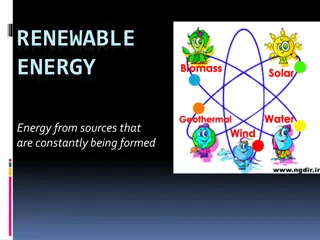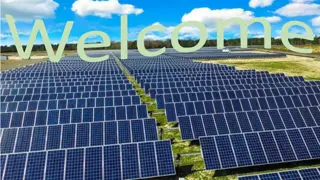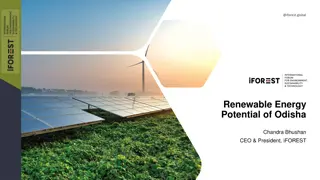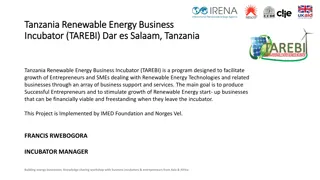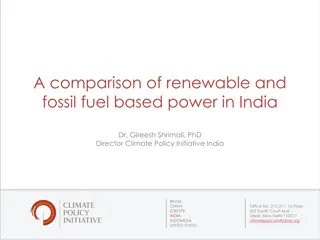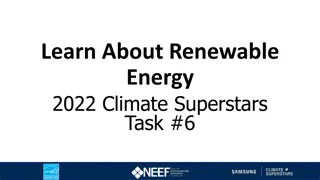Advancing Renewable Energy in South Africa: SAREC Presentation Highlights
SAREC, the South African Renewable Energy Council, plays a vital role in promoting the renewable energy sector in South Africa. Their objectives include supporting a just energy transition, engaging with government, promoting excellence in renewable energy, and collaborating with various organizations for sustainable development. The presentation emphasizes the importance of the energy sector, the role of renewables in the future, job creation, economic growth, climate change mitigation, and restructuring the electricity supply industry for a low-carbon economy.
Uploaded on Aug 02, 2024 | 4 Views
Download Presentation

Please find below an Image/Link to download the presentation.
The content on the website is provided AS IS for your information and personal use only. It may not be sold, licensed, or shared on other websites without obtaining consent from the author. Download presentation by click this link. If you encounter any issues during the download, it is possible that the publisher has removed the file from their server.
E N D
Presentation Transcript
Terence Govender Terence Govender Chairperson Chairperson South African Renewable Energy Council South African Renewable Energy Council 083 449 0433 083 449 0433 Portfolio Committee on Mineral Resources and Energy Portfolio Committee on Mineral Resources and Energy 21 August 2019 10:00- 19:00 Venue: Parliament, S12 A, Ground Floor, NCOP Building 1
AGENDA AGENDA Who is SAREC? Summary of the Presentation Constraints, Opportunities, RE Highlights RE Contribution to the Energy Mix Energy and the Future How Can We Work Together? Some Key Take-Away Points 2
WHO IS THE WHO IS THE SOUTH AFRICAN RENEWABLE ENERGY COUNCIL? SOUTH AFRICAN RENEWABLE ENERGY COUNCIL? MAIN OBJECTIVE Promote the Renewable Energy Sector in South Africa by acting as an umbrella body for renewable energy industry associations, including SAPVIA, STASA, SAWEA, SAESA & SESSA and furthermore act as a point of contact on matters of common interest in RE industry . GOALS To promote the use of large scale and small Renewable Energy; To the point of contact and provide expert resources to support Government in the formulation & execution of energy policies; To promote a just energy transition that encompasses public and private sector coordination towards the expansion of the economy, the low carbon economy, job creation, cost optimization of RE generation & localization of the RE industry; To engage with other active SA organizations in the broader fields of climate change mitigation/adaptation and sustainable development Act as a liaison to local and international media regarding RE in South Africa; To promote excellence in RE and related areas of business and to provide information to government, media and the public on behalf of the industry. 3
SUMMARY OF THE PRESENTATION SUMMARY OF THE PRESENTATION 1. SAREC is the point of contact for the RE industry: to manage the constraints in the Energy Sector and implementation of RE is various sectors- small scale, large scale, energy storage and energy efficiency based on local and international experiences. 2. Energy and the future: we support the low carbon economy (drive) transition as per the NDP and per SA s international commitments. Solutions drive to mitigate climate change. 3. The Just Energy Transition in partnership with the Private Sector, organised Labour, Civil Society and various Organs of State - boost the economy by ensuring security of clean, low cost energy supply and enhanced trade opportunities (e.g. electric vehicle manufacture). 4. We support scaling up free fuel renewables in a Diversified Energy Mix- the IRP high intensity jobs & skills development, rare minerals & value added manufacturing, achieving carbon reduction targets, boosting economic development for communities and SMMEs, achieving economically competitive LCOE together with other power generating facilities. 5. We call for the restructuring of the Electricity Supply Industry to meet the targets of the low carbon economy, to stimulate economic growth and FDI, and increase GDP. 4
OPPORTUNITIES AND CHALLENGES OPPORTUNITIES AND CHALLENGES 1. Opportunities Contribution to the Energy Mix- large scale and small scale, together with storage and up stream benefits: EV. Drive the costs down of electricity for all sectors to benefit- Mining, Agriculture, Manufacturing, Transport. Contribution to job creation and reskilling, news skills development, industrialisation, power generation. Quick timelines for integration of power into the grid. Storage options- battery and high temperature HTF- CSP (oils and salts). Non Recourse funding and FDI opportunities. Benefit from the world wide implementation of RE- lower costs, mining solutions- EV (top 40 minerals and metals). LCOE due to international demand and implementation. 2. Challenges Mining Sector and manufacturing sector facing challenges with the high cost of electricity- since 2008. Approx. 75% gold mines are non profitable. Just Energy Transition- balance between existing structures: Coal sector and RE. Delayed policy approvals in RSA, i.e. IRP, IEP. Inconsistent procurement. Investment in manufacturing? The Grid investment. Eskom as the single buyer. 5
INTERNATIONAL RE STATS INTERNATIONAL RE STATS 1. 2018 total of 181 GW of renewable power was added- USD 289 bil. 2. Renewable Energy became increasingly cost-competitive compared to conventional thermal generation. 3. Renewables provided an estimated 26% of global electricity generation by year end. Uptake has been driven by targets and stable policies. 4. Decarbonisation targets, pathways and frameworks were developed further during 2018. 5. Developing and emerging economies continued to increase their deployment of renewables, and distributed renewable energy systems further helped to spread energy access to households in remote areas. 6. As of 2018, renewable energy accounted for an estimated 23%% of total final energy consumption (TFEC). 7. Opportunities continue to grow for increased use of renewable electricity in end-use sectors. 8. Sector integration attracted the attention of policy makers, and the markets for enabling technologies grew (such as battery storage, heat pumps and electric vehicles). 9. The world is not on track to meet the targets of the Paris Agreement or of Sustainable Development Goal 7. Global energy-related CO2 emissions grew an estimated 1.7% in 2018 due to increased fossil fuel consumption. 6
INTERNATIONAL RE STATS INTERNATIONAL RE STATS 7
SA MARKET: SA MARKET: REIPPP INVESTMENT, ECONOMIC, SOCIAL IMPACTS REIPPP INVESTMENT, ECONOMIC, SOCIAL IMPACTS Greater than 6000 MW procured World class procurement system. Balanced the tariff with key NDP and Government focus: Jobs, Skills, ED, SED, localization, Local investment, local procurement, Local Management etc. Total investment: R250 billion (25% foreign investment attracted) Job years created for RSA citizens: greater than 42 000 Socio-economic development contributions: greater than R860 million Enterprise development contributions: greater than R280 million Carbon emission reductions: greater than 36 M ton CO2 Water savings: greater than 43 million kiloliters Assisted in reduced load shedding, sustainable support for life of project: ED, SED, Manufacturing Stats provided as of end March 2019 : Source: IPPPP Overview 8
KEY EXPECTATIONS FROM DMRE, PPCE, SAREC KEY EXPECTATIONS FROM DMRE, PPCE, SAREC SAREC to become the point of contact for DMRE/PPCE- to address the challengers and opportunities. Initiate the dialogue/workshop together with a Just Energy Transition Action Plan (JETAP) supported by business, labour and civil society- Balance and sustainability in Mining vs Energy. Renewable energy and storage can create jobs, attract investment and manufacturing, but this requires a stable and consistent policy environment in a form of a regularly updated IRP- Sharing of industry related data to support energy research including SSEG and Energy Efficiency- Finalise the IRP and update at least once every 2 years. (IRP, SSEG rules, Wheeling rules and Energy Efficiency) Procurement, rules and benefits: Continuous Procurement ensures stable grid and growth in the economy. Ensure adequate and timely procurement to benefit from major cost reduction: yearly Procure energy for storage benefits and baseload A continuous procurement for renewable energy to maximize the benefit of industrialisation and job creation/from other sectors. Blend rules into the RFP- tariff vs NDP, Mining, Localisation, other sector benefits (Eskom) 9
CONTINUED... CONTINUED... Generation and Funding: Energy and the future: we support the low carbon economy: increased renewables in the mix RE contribution to SA economy: attracts foreign direct investment, creates new geographically distributed jobs across the value chain, contributes to socio-economic development, contributes to industrialisation and new skills development To ensure stable energy sector, we call for the restructuring of the Electricity supply industry Network system operator- access to the grid. Stable single buyer of the RE power. 10
ENERGY AND THE FUTURE ENERGY AND THE FUTURE The energy sector transition is influenced by global trends such as decarbonisation, decentralisation, democratisation, digitisation and disruptor technologies There are challenges that South Africa faces to transition from a carbon intensive energy mix to a lower carbon economy as envisaged in both the National Development Plan (NDP), and in line with South Africa s Nationally Determined Contributions (NDCs). A large share of SA s coal power installed capacity (12.6 GW, according to IRP 2018) is nearing end of life and due for decommissioning over the next decade. This capacity needs to be replaced with clean affordable and quick to build capacity that is based on principles of a least cost energy mix and generation mix needs to be optimized for most cost -effective system. The costs and benefits of technologies covered by SAREC, depending on implementation, can reduce costs of transmission and distribution. The IRP 2018 recommended plan prescribes a new build plan that is based on renewables and gas as an ideal least cost energy mix These input figures have changed over last year to even more improved with storage being a player SAREC position is that the ideal energy mix should be decided on the basis of least cost, as a foundation, then justifiable policy adjustments (including cost implications thereof) can be made to inform the final energy mix. SAREC would like to call for the finalisation of the IRP in order to fast-track procurement of new generation capacity. SAREC commits to working with government to ensure that the ideal energy mix embraces the principles of a just energy transition 11
JUST ENERGY TRANSITION & IRP JUST ENERGY TRANSITION & IRP The envisaged economic decline and subsequent jobs losses in coal based regions is a direct outcome of the decline in coal demand as a result of a planned decommissioning of power stations over the next 10 years as well as a decline in coal exports; it is not due to renewable energy deployment With that said, SAREC recognises the need for a concerted effort to minimise the negative economic impacts of the transition, especially on the labour force and local communities in impacted regions. SAREC Proposal: Deliberate deployment of renewable energy projects (5GW) in Renewable Energy Development Zones (REDZs) located in declining mining areas to assist in the just energy transition by creating new jobs, developing new skills and attracting new RE investment into these regions. To successfully achieve this the industry requires an urgent finalisation of the IRP, finalisation of REDZ phase 2, issuance of ministerial determinations over the IRP period and announcement of the next round of procurement and resolving the stalled SSEG regulations SAREC is committed to a Just Energy Transition and calls for: An urgent dialogue between government (all spheres), business, labour and civil society on Just Energy Transition A clear, action orientated, government-led Just Energy Transition Action Plan with hard targets A clear strategy on diversification of the economies in the coal based regions 12
SSEG/EE AND ECONOMIC, SOCIAL & SSEG/EE AND ECONOMIC, SOCIAL & ENVIRONMENTAL IMPACTS, STORAGE ENVIRONMENTAL IMPACTS, STORAGE For the first time the IRP incorporates distributed or embedded generation. Allocation for the category between 2019 and 2022, the updated draft says it will be allocated to the extent of the short-term capacity and energy gap. SSEG however needs market development and market implementation which is restricted by regulations not being finalised. SSEG allows for expanding access to modern, reliable and affordable energy in South Africa and contributes greatly to our primary objective towards achieving sustainable development in all sectors of the economy. SSEG and the associated services, offer significant employment opportunities, growth of localization opportunities and great contribution to SA decarbonization targets. Energy Efficiency such as water heating fits into this category. Storage will form a key part of power generation in the future: CSP, Batteries, Hydro, and other new technologies. 13
CONCLUSION CONCLUSION SAREC to become the point of contact Initiate the dialogue/workshop together with a Just Energy Transition Action Plan (JETAP) IRP- update at least once every 2 years. (IRP, SSEG rules, Wheeling rules and Energy Efficiency- Munics buying from IPPs) Procurement of Baseload, RE, Storage in the short term. ESI restructuring and how Eskom or System operator buys power and is a player in the IPP model. 14
CONTACT Terence Govender Chairperson +27 83 449 0433 Terence@eluenergy.co.za @SAREC_SA General enquiries www.sarec.org.za admin@sarec.org.za 15
SOUTH AFRICAN PHOTOVOLTAIC ASSOCIATION SOUTH AFRICAN PHOTOVOLTAIC ASSOCIATION The South African Photovoltaic Industry Association (SAPVIA) is a registered not-for-profit association representing members largely made up of developers, manufacturers and service providers operating within the Photovoltaic (PV) industry Inform its Members on the latest legislative developments, Anticipate legislation having a potential impact on the sector, Advise key decision-makers on the most adequate policies to develop a sustainable PV market, Mobilize the sector via working groups and workshops to define clear positions on political, technical and economic issues, Promote a higher penetration of the technology, Facilitate business-to-business contacts among industry stakeholders, Support national organisations in achieving their local objectives, Organizes conferences where solar electricity has strong potential and requires additional support 16
SOUTH AFRICAN WIND ENERGY ASSOCIATION SOUTH AFRICAN WIND ENERGY ASSOCIATION The South African Wind Energy Association (SAWEA) represents the interests of its members who are invested in the South African wind power value chain. SAWEA activities are focused on: Advocacy for investment in wind power; Promotion of socio-economic development and transformation through wind power; Excellent operational practice in the generation of wind power; Provision of pertinent information on the SA wind power market; Promotion of renewable power in large and small-scale applications; Promotion of wind and renewable power investment in Africa 17
SOLAR THERMAL ASSOCIATION OF SOUTHERN AFRICA SOLAR THERMAL ASSOCIATION OF SOUTHERN AFRICA STASA has been setup by key players in the Concentrated Solar Power (CSP) industry in response to the current challenges in the Renewable Energy (RE) market in South Africa and to boost solar development across Southern Africa. Established to promote CSP Technology in the Southern African Energy Market by large International/ Local companies. Represents all CSP technologies The advancement of CSP technology and its inclusion into the generation mix in South Africa IRP; and for grid benefits. To ensure the sustainability of the CSP industry in the RE development landscape and its technology benefits 18
SUSTAINABLE ENERGY SOCIETY OF SOUTHERN AFRICA SUSTAINABLE ENERGY SOCIETY OF SOUTHERN AFRICA The mission of SESSA is the creation and continued growth of an authoritative renewable energy forum, in Southern Africa. SESSA has the following objectives: To promote and increase the use of renewable energy with informal education, demonstration and information dissemination to end-users and other decision makers of all levels; To establish the society as the main regional information centre in close co-operation with similar initiatives; To facilitate in the creation and maintenance of appropriate standards for products, systems or methods and training. 19
SOUTH AFRICAN ENERGY STORAGE ASSOCIATION SOUTH AFRICAN ENERGY STORAGE ASSOCIATION SAESA aims to promote Energy Storage in South Africa and Africa. Vision: To guide policy to allow for the accessibility of storage To advocate and advance the energy storage industry in SA Mission: To create a more resilient, accessible, efficient, sustainable, and affordable energy system in Africa. To educate stakeholders, advocate for public policies, accelerate energy storage growth, and add value to the energy storage 20

 undefined
undefined









